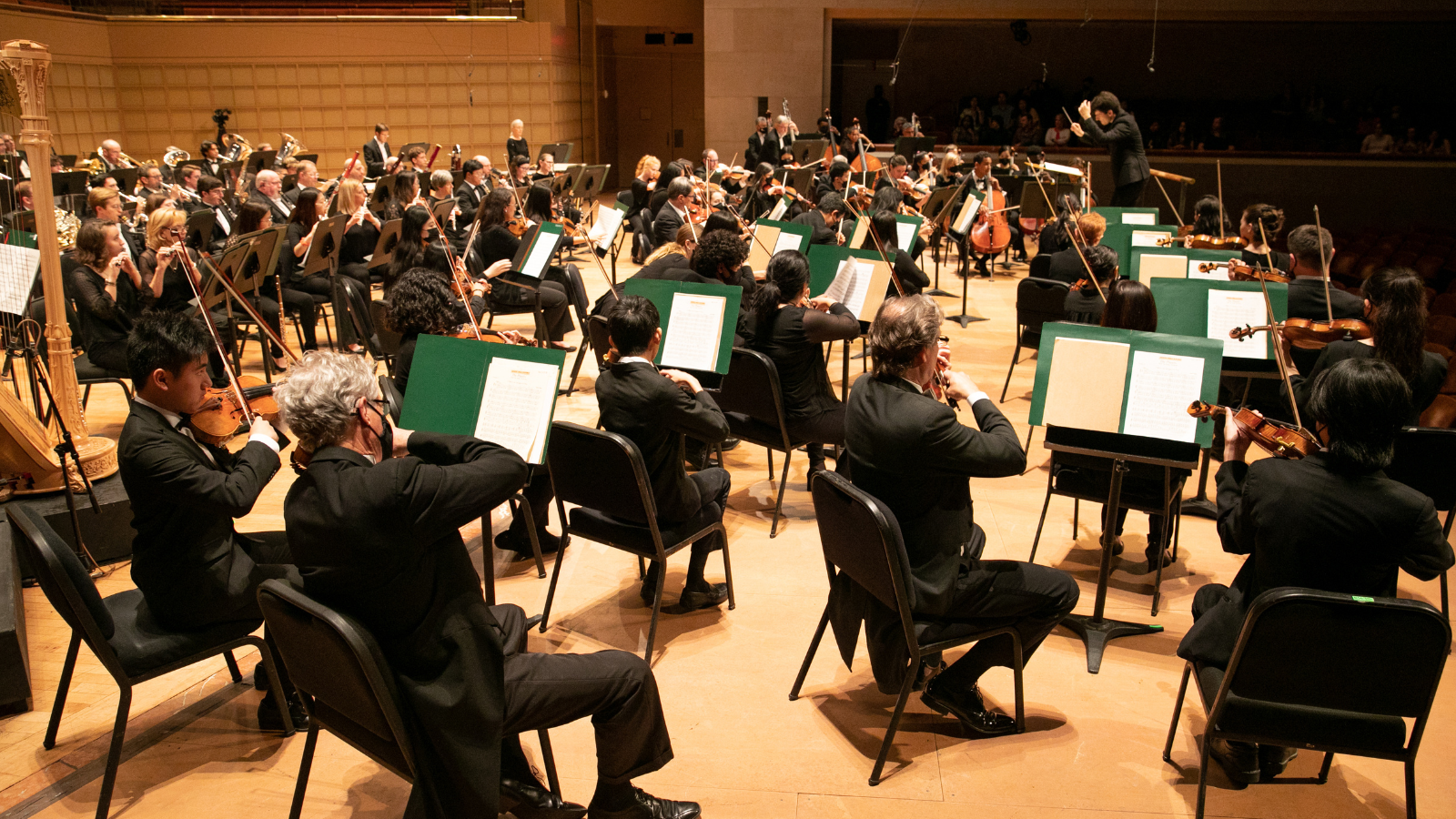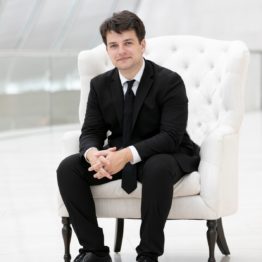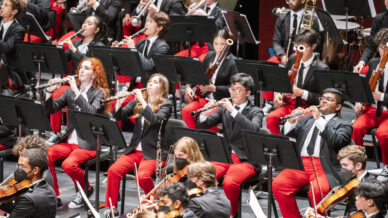

Concierto para piano nº 1 de Chaikovski | Annual Side-by-Side
9 de junio de 2023
MAURICE COHN lleva a cabo
JACK ROUECHE piano | Concurso de Conciertos Lynn Harrell
GRAN ORQUESTA JUVENIL DE DALLAS
ORQUESTA SINFÓNICA DE DALLAS
BOULANGER De una mañana de primavera
TCHAIKOVSKY Concierto para piano nº 1
DEBUSSY Preludio de la Tarde del Fauno
SIBELIUS Suite Karelia
SMETANA Baile de los cómicos
Una experiencia de concierto especial de una sola noche, con Jack Roueche, ganador del Concurso de Conciertos Lynn Harrell 2023, y una actuación conjunta de la DSO y la Greater Dallas Youth Orchestra. Presentado con la ayuda del Consejo de Adolescentes de la Sinfónica de Dallas, únase a nosotros una hora antes del concierto para las actividades previas al concierto, incluidos los preludios de la actuación y un photobooth especial, y después de la actuación para un helado social posterior al concierto.
Notas del programa
por René Spencer Saller
Lili Boulanger nació en París (Francia) en 1893. Era hija de Ernest Boulanger, profesor de conservatorio y compositor conocido por sus óperas, y de Raissa Myshetskaya, princesa rusa y vocalista de San Petersburgo. Incluso después del fallecimiento de su padre, cuando ella sólo tenía tres años, su vida siguió girando en torno a la música. Su madre aprendió armonía para enseñar a sus hijos, que empezaron a leer, tocar y componer música a edades tempranas.
Boulanger ingresó en el Conservatorio de París en 1909, a los 16 años, donde estudió composición con Georges Gaussade y Paul Vidal. A pesar de sus luchas contra el deterioro de su salud, encontró su propia personalidad musical y compuso continuamente a lo largo de su corta vida. Ganó el Prix Lepaulle tras sólo un año en el Conservatorio y fue la primera mujer en recibir el Gran Premio de Roma de música con sólo 19 años.
Mientras su salud seguía deteriorándose, compuso un importante corpus de obras vocales e instrumentales que tuvieron un gran impacto en el mundo musical. Abrió nuevos caminos para las compositoras antes de morir a los 24 años. "La suya fue una vida creative de algo más que meras promesas; fue una vida, al menos, de realización parcial". David Noakes, musicólogo, elogió la obra de Boulanger tras su muerte, y Nadia, la hermana mayor de Lili, se dedicó a mantener viva la música de su hermana. Nadia se convirtió en la maestra y mentora más influyente del siglo XX para otros compositores, aunque nunca se consideró a sí misma como tal, a pesar de su impacto en los compositores de entonces y de ahora.
D'un Matin de printemps (De una mañana de primavera) se estrenó el 13 de marzo de 1921 en París, Francia. Esta obra fue una de las últimas partituras escritas de puño y letra de Boulanger. La compositora escribió cada una de sus obras en tres versiones, una para orquesta, otra para trío con piano y una tercera para violín (ocasionalmente flauta) y piano. La partitura incluye flautín, dos flautas, dos oboes, corno inglés, dos clarinetes, clarinete bajo, dos fagotes, contrafagot, cuatro trompas, tres trompetas, tres trombones, tuba, timbales, platillos, caja, triángulo y las cuerdas habituales.
D'un Matin de Printemps (De una mañana de primavera) se completó junto con D'un Soir triste (De una noche triste) en 1918. Ambas tienen ideas comunes en cuanto a su tema, pero representan estados de ánimo opuestos, implícitos en sus títulos. Estas piezas fueron compuestas durante los últimos meses de su corta vida.
D'un Soir triste transmite una desesperación inconsolable, pero a medida que la obra avanza, se percibe el sabor de algo más luminoso en los momentos finales de la obra. D'un Matin de printemps retoma el tema justo donde lo deja esta sugerencia de esperanza, trayendo la sensación del amanecer. Su apertura está florecida con ligeras notas de corchea que se escuchan en las cuerdas y que proporcionan impulso cuando la flauta entra con la melodía. Al igual que en la música francesa de esta época, los vientos ocupan un lugar destacado, aportando vitalidad a la pieza. La mañana primaveral no concluye sin su propia oscuridad a pesar de su brillante apertura. Una vez que los metales y la percusión se unen al conjunto, la energía se hunde en un estado más oscuro y turbio.
Boulanger emplea la alusión al color y la textura en la música para continuar la batalla entre dos reinos. Uno de ellos se retrata como brillante y alerta, reafirmando el tema principal en los vientos como una llamada de atención con un tempo rápido. El otro se transmite como onírico, marcado en la música como mysterieux, que significa misterioso o extraño, con sonidos fantasmales de violín que realzan el efecto del tema. A medida que la pieza avanza, la energía ligera y elástica inicial regresa en una serie de crescendos y el ascenso del conjunto se resuelve finalmente con un glissando del arpa.
Ignorando el sentido moderno de la palabra, la mejor manera de describir a Peter Ilyich Tchaikovsky es como bipolar. El mismo día escribía a un amigo que "cada día estoy más deprimido", mientras que más tarde escribía a su hermano Modest que sus éxitos eran tan grandes que "pronto [su] fama le aplastará [a Modest]". También era conocido por tener opiniones muy diferentes sobre sus obras en un lapso de veinticuatro horas. Su Obertura en do menor era una pieza que le había gustado, pero más tarde marcó las palabras 'Basura horribleen la partitura. Del mismo modo, Tchaikovsky se mostró extasiado por el arte de esta Cuarta Sinfonía el día del estreno, pero la condenó al día siguiente, a pesar de la buena acogida que tuvo entre el público.
Chaikovski alcanzó su plenitud compositiva en una época en la que los "Cinco Poderosos" dominaban la escena musical rusa. Los "Cinco Poderosos", también llamados el "Puñado Poderoso", eran un grupo de cinco compositores rusos. Entre ellos estaban Rimsky-Korsakov, Mussorgsky, Cui, Borodin y Balakirev. Como alumno de Nikolay Rubenstein en el Conservatorio de San Petersburgo, la música de Chaikovski fue atacada por estos cinco compositores. Sin embargo, la independencia de Chaikovski respecto a los "Cinco Poderosos" le granjeó una reputación independiente de estos otros compositores rusos y le permitió ocupar un lugar competitivo en la escena musical rusa.
Nikolay Rubinstein era un profesor implacable. Una de las primeras piezas de Chaikovski, la Obertura en do menor, fue declarada "inadecuada" por su profesor. Rubinstein era conocido por su mal genio, y Chaikovski, que se alojaba en casa de Rubinstein tras su graduación en el Conservatorio de San Petersburgo, temía trabajar hasta altas horas de la noche por miedo a que el rascar de su pluma despertara a su profesor. Sin embargo, la tutoría de Rubinstein tenía sus ventajas. A través de Rubinstein, Chaikovski pudo conocer a muchos de los músicos más destacados de Rusia, y muchos de ellos, como el violonchelista Karl Albrecht y el crítico Nikolay Kashkin, se convertirían en amigos para toda la vida. Según el hermano de Chaikovski, Modest, "todo Moscú estaba personificado en Rubinstein... de quien no es exagerado decir que fue la mayor y más duradera influencia en la carrera de Chaikovski". Nadie, artista o amigo, hizo tanto por el avance de su fama, le dio mayor apoyo o afecto, o le ayudó más a vencer su nerviosismo y timidez iniciales."
Al principio, Chaikovski era una persona muy nerviosa. A diferencia de muchos compositores que dirigían sus propias obras, Chaikovski a menudo era incapaz. Tenía un miedo irracional a que se le cayera la cabeza mientras dirigía y era conocido por mantener una mano en la cabeza y la otra en la batuta en las raras ocasiones en que dirigía una de sus obras. Durante el estreno de su primera sinfonía, un crítico escribió que "desde el momento en que apareció Pyotyr Illyich [era] un manojo de nervios... Cuando por fin subió al podio, parecía que preferiría estar en cualquier otro sitio. Olvidó cada nota de su pieza y no dio indicaciones a los músicos en los momentos más cruciales. Por suerte, la orquesta conocía tan bien la obra que no hizo caso de su inepto director ni de sus instrucciones incorrectas. Interpretaron la pieza perfectamente, mirando de vez en cuando al compositor con una gran sonrisa en la cara". Afortunadamente, la sinfonía fue bien recibida y Chaikovski juró no volver a dirigirla.
Una escucha más atenta
Al igual que la Obertura en do menor de Chaikovski, Rubinstein pensó inicialmente que el Primer Concierto para Piano de Chaikovski era "inútil e injugable". Tchaikovsky esperaba que Rubinstein aceptara interpretar el estreno, pero Rubinstein se negó a menos que se hicieran grandes revisiones a la pieza. Tchaikovsky, que no estaba dispuesto a hacer estas modificaciones, llevó la obra al pianista Hans von Bülow, que aceptó estrenarla. El 25 de octubre de 1875, el Primer concierto para piano de Chaikovski se interpretó en Boston durante la gira americana de Bülow. La obra fue muy bien recibida allí, y supuso un gran éxito para Chaikovski. Con el tiempo, el Concierto para piano obtuvo el mismo éxito en Europa, y Rubinstein incluso aceptó dirigir la obra.
El Primer concierto para piano de Chaikovski se abre con una grandiosa línea descendente en las trompas, seguida de golpes orquestales fortissimo. A continuación, el piano entra con enormes acordes mientras las cuerdas retoman una melodía arrebatadora y majestuosa. A diferencia de la mayoría de las piezas, esta famosa melodía sólo se repite una vez más, antes de desaparecer del resto del concierto. La melodía inicial se basa en una canción popular ucraniana que Chaikovski escuchó en las calles de Kiev. El grandioso y expansivo primer movimiento es el más conocido y memorable del concierto. El segundo movimiento es más ligero y lento que el primero. Marcado como andantino semplice, este movimiento es sencillo y bello. La sección comienza con pizzicato en las cuerdas, luego una melodía es retomada por la flauta solista. Entra el piano y, con él, el fagot. Las cuerdas también vuelven al arco normal. En esta parte del concierto brilla la elegancia y la delicadeza presentes en la música de ballet de Chaikovski, y se escucha una faceta diferente de Chaikovski.
El tercer movimiento, escrito en forma de rondó, es rápido y virtuoso. La forma rondó se caracteriza por la aparición y reaparición de una melodía inicial. Este movimiento también incluye bastantes juegos y conversaciones entre el solista y la orquesta. La orquesta pasa una introducción entre secciones, y el piano retoma y desarrolla rápidamente esta melodía. El piano termina la melodía, y la orquesta la reintroduce rápidamente. La pieza termina con una conversación entre el piano y la orquesta, que culmina con una nota larga fortissimo sostenida por los músicos.
Desde su estreno, el Primer Concierto para Piano de Chaikovski ha suscitado la adoración del público. Menos mal que Chaikovski no se dejó amilanar por las críticas iniciales de Rubinstein. Hay algo que decir sobre la negativa de Chaikovski a hacer las revisiones de Rubinstein. Quizá la honestidad musical sea más importante que la aprobación de sus superiores.
Claude Achille Debussy (1862-1918) fue un compositor impresionista francés que sentía un gran amor por el arte de muchos tipos. Desde pintores hasta poetas, los amigos más cercanos de Debussy no eran compositores, sino otro tipo de artistas. De hecho, Debussy miraba con desprecio a la mayoría de sus colegas compositores. Massanet mostraba "un talento extraordinario para satisfacer todo lo que es poéticamente vacío y líricamente barato", Stravinsky era "un niño mimado... que lleva corbatas ruidosas y besa las manos de las damas mientras les pisa los dedos de los pies", y Fauré no era mejor que un "sirviente musical de un grupo de esnobs e imbéciles".
Debussy sentía a menudo que la música era incomprendida por sus colegas y el público en general. En una carta a André Poniatowski, un mecenas suyo, Debussy reveló que su gran ambición era "dirigir [su] propio espectáculo a [su] manera y erradicar la imbecilidad en la comprensión musical que [los] últimos años [habían] fomentado en los amables oyentes de [su] época". Condenaba a los artistas por adular al público en lugar de hacer arte honesto. Debussy creía que los compositores "deben escribir música que contenga la totalidad de [su] vida, no sólo un poco de ella hecha atractiva sólo por un escenario elegante y por la conversación ociosa de aquellos que no componen".
La actitud del público hacia lo que Debussy consideraba arte honesto y la falta de aprecio por su música temprana sumieron a Debussy en una depresión casi constante. Tras ganar el Prix de Rome en 1884, se marchó a Villa Médicis. Sin embargo, se sintió tan infeliz a causa de las creencias e ideas de sus compañeros artistas que acabó marchándose a los pocos meses. Debussy luchó toda su vida por cambiar la cultura musical de París. A menudo se sentía prisionero del público. Necesitaba ganarse la vida con su música, pero muchos no encontraban su música tan bella o armónicamente agradable como la de otros compositores importantes de la época de Debussy. Aunque anhelaba cambiar la cultura parisina, Debussy se vio obligado, en ocasiones, a escribir música que complaciera al público, aunque contrastara con sus ideales. Sin embargo, Debussy era capaz de sentirse orgulloso de su trabajo, y sus depresiones se veían salpicadas por ocasionales estallidos de felicidad. El compositor estaba realmente satisfecho con su Ibéria y encontró un verdadero placer en la naturaleza inmaterial y la improvisación de la pieza. Se pueden encontrar texturas similares en Preludio de la tarde de un faunoque compuso años antes.
Una escucha más atenta
La obra de Stéphane Mallermé Faune cuenta la historia de Pan, el sátiro o fauno griego que es mitad hombre y mitad cabra. Pan persigue a Syrinx, una ninfa y su amor, que se ha metamorfoseado en juncos. Pan, angustiado por la pérdida de Syrinx, toca una música hermosa y triste con su flauta. El poema de Mallarmé es perfecto para un compositor como Debussy, autoproclamado como alguien "demasiado propenso a soñar [su] vida y a ver las realidades sólo en el momento en que se vuelven insuperables". El poema va y viene entre el sueño y la vigilia, el pasado y el presente, la música de flauta y la historia. Tras meses sin inspiración artística, Debussy quedó extasiado al encontrar por fin el poema de Mallarmé, que creía a la altura de su talento artístico. Debussy se apresuró a conseguir el permiso para poner música al poema, que Mallarmé le concedió encantado. Mallarmé escribe:
Ninguna corriente va sino la que mi flauta vierte, Sobre arboledas rociadas de asentimiento; la brisa solitaria- Ágil de mi pipa doble - se alivia:Para derramar el sonido en árida lluvia Y luego, en el plano del mundo no mutilado,Ser aliento - visible, sereno, enviado por el hombre - De inspiración, alojado en el firmamento.
Naturalmente, Debussy comienza su Fauno con un solo de flauta, actualmente uno de los solos de flauta más famosos del repertorio orquestal. A continuación, la orquestación se abre y se escuchan el arpa, la trompa y las cuerdas. Preludio de la tarde de un fauno está escrito esencialmente en tres partes: La primera parte está definida por esa melodía principal de flauta pasada entre distintos instrumentos, la segunda por la ausencia de esa melodía y la tercera por la reaparición de la melodía inicial. La pieza de Debussy es una batalla constante entre las tonalidades de Do sostenido y Mi para lograr el dominio. La tonalidad de Do sostenido, presentada en primer lugar en el solo de flauta, representa la tonalidad de Mallarmé. Fauney la clave de Mi representa el Por la tarde y el Destino que se llevó a Syrinx. Al igual que en el poema de Mallarmé, Debussy intenta captar la sensación de un recuerdo que está fuera de nuestro alcance. A través de este conflicto de tonalidades y de diversas armonías poco convencionales, Debussy es el único compositor que ha sido capaz de trasladar con éxito a la música el retorcido paisaje onírico de Mallarmé.
Habla el compositor
Para Debussy era muy importante representar fielmente la obra de Mallarmé. Faune. En palabras de Debussy, "si la música siguiera más de cerca [el poema] se quedaría sin aliento, como un caballo de tiro compitiendo por el Grand Prix con un pura sangre". A pesar de todas sus críticas a otros compositores, Debussy se cuidaba de practicar lo que predicaba. Se mantuvo alejado de un "saber constructivo" que era "una carga para [los] intelectos más finos". Lo que el oyente escucha en la pieza es exactamente lo que Debussy proclama: "¡No respeta la tonalidad!". En su lugar, está escrita en "un modo que pretende contener todos los matices". No obstante, sigue la forma ascendente del poema, así como el paisaje tan maravillosamente descrito en el texto, ¡junto con la humanidad que le aportan treinta y dos violinistas que se han levantado demasiado temprano! En cuanto al final, es una prolongación del último verso: 'Despedida de pareja, voy a ver en qué te has convertido'". Y en efecto, Fauno se convirtió. Las bellezas de Preludio de la tarde de un fauno han perdurado durante décadas. La naturaleza onírica de la pieza y la imagen de un recuerdo fragmentado han resonado en la gente desde su estreno. No es de extrañar que esta obra maestra haya resistido el paso del tiempo.
Jean Sibelius fue un compositor finlandés y un icono nacional. Siempre le fascinó la cultura finlandesa, especialmente un texto mitológico finlandés, el Kalevala. La mayor parte de la música de Sibelius fue escrita sobre Finlandia, y su estilo nacionalista surgió en una época en la que Finlandia estaba en proceso de independizarse de Rusia. Durante esta época, el público finlandés conectó mucho con su música, y su Finlandia se convirtió incluso en el himno no oficial de Finlandia. Sibelius era tan respetado que el Estado le daba una suma anual de dinero para que las preocupaciones monetarias no le impidieran componer, y su imagen llegó a aparecer en el billete finlandés de cien marcos.
Toda su vida, Sibelius sintió una fuerte conexión con la naturaleza, y la utiliza como guía para muchas de sus piezas. Escribió bastantes piezas sobre la campiña finlandesa, entre ellas Höstkväll (Atardecer de otoño) y På verandan vid havet (En un balcón junto al mar). Incluso su primera obra sobreviviente, Vattendroppar (Gotas de agua)estaba relacionado con la naturaleza. De niño, Sibelius paseaba por los bosques improvisando con el violín y, más tarde, escribió un diario lleno de notas sobre la belleza de la naturaleza. Sibelius sentía un interés especial por las aves migratorias, como los cisnes y las grullas, y llegó a decir: "Hace millones de años, en mis encarnaciones anteriores, debí de estar emparentado con los cisnes".
Sibelius era un compositor muy crítico. Después de publicar su Quinta Sinfonía, se retractó de ella dos veces para editarla. Sólo después de la segunda vez consideró que era apta para una verdadera publicación. Sibelius pasó tanto tiempo revisando su Quinta Sinfonía que su finalización se solapó con la de la Sexta y Séptima sinfonías, y en una carta escribió que "parece como si pudiera salir con las tres sinfonías al mismo tiempo". Hacia el final de su carrera como compositor, Sibelius quemó varios de sus manuscritos. Entre ellos, su inacabada Octava Sinfonía, que nunca llegó a publicarse, y el manuscrito original de la Suite Karelia. Sin embargo, el Suite Karelia se reconstruyó a partir de las partes orquestales conservadas, y desde entonces ha sido una de las favoritas de los conciertos.
Una escucha más atenta
Carelia es una provincia finlandesa y un centro de la cultura finlandesa. La provincia es fuente de gran parte del material del KalevalaEl carelianismo, movimiento nacionalista finlandés, procedía de esta región. El carelianismo fue un movimiento con el que Sibelius se identificó estrechamente durante toda su vida. Carelia fue compuesta para la Asociación de Estudiantes Viipuri con motivo de un retablo histórico en la Universidad de Helsinki, en Vyborg. Debido al fuerte significado nacionalista de la pieza, Carelia fue muy bien recibida en su estreno. En una de sus cartas, Sibelius afirmaba que "no se oía ni una sola nota de la música: todo el mundo estaba de pie aplaudiendo y vitoreando". Sin embargo, cabe señalar que el original Carelia fue revisada por el compositor y adaptada en el Suite Karelia.
El Suite Karelia se compuso en tres movimientos, cada uno de los cuales representa un elemento de la cultura finlandesa. El primer movimiento se abre con cuerdas, que sientan las bases para las suaves llamadas de las trompas. Las trompas prolongan la frase original y el movimiento adquiere un tono más grandioso. Este movimiento pretende representar una procesión de carelios que pagan impuestos a un duque opresor de Lituania. El segundo movimiento es más introspectivo, con un solo de corno inglés que representa la voz de un bardo. Este movimiento capta la melancolía reflexiva que Karl Knutsson, un rey, siente al escuchar la canción de su bardo. El tercer movimiento fue escrito como una marcha, y su atmósfera grandiosa y majestuosa lo convierte en una elección habitual como pieza independiente. Se escuchan fanfarrias de metales y flautines tocando un tema victorioso. El retablo original representaba la destrucción de una ciudad, pero Sibelius lo reescribió para que fuera brillante y animado. La pieza concluye con una parte del himno nacional finlandés.
Sibelius siempre se aseguró de elaborar cada frase con esmero. El compositor daba el consejo de "no escribir nunca una nota superflua; cada nota debe vivir". Fue un lema que Sibelius llevó consigo toda su vida, y por eso era conocido por quemar manuscritos. Sibelius nos lanza un reto a todos: nunca digas una palabra inútil, nunca desperdicies un momento y nunca te permitas dar menos de lo mejor de ti mismo.
Bedřich Smetana fue un compositor checo considerado el padre de la música checa en su patria por ser pionero en el desarrollo de un estilo musical estrechamente identificado con las aspiraciones y culturas de su pueblo.
Es conocido sobre todo por su ópera de 1866 La novia de trueque que retrata la historia, las leyendas y los paisajes de la Bohemia native del compositor.
Smetana era un compositor dotado por naturaleza y dio su primera actuación en público a los seis años. Tras una escolarización convencional, viajó a Praga, donde estudió con Josef Proksch.
Abandonó Praga brevemente para viajar a Suecia, donde impartió clases y comenzó a escribir algunas de sus obras orquestales a gran escala, para regresar definitivamente a Praga en la década de 1860.
Sus dos primeras óperas Los Brandemburgueses en Bohemia y La novia de trueque se estrenaron en el nuevo Teatro Provisional, alcanzando la última de las piezas una gran popularidad. Smetana se convirtió rápidamente en el principal director de orquesta del teatro, hasta que la polémica suscitada por su identificación con las ideas progresistas de Franz Liszt y Richard Wagner interfirió en su labor creative y precipitó su dimisión del teatro en 1874.
Incluso después de quedarse completamente sordo en 1874, consiguió mantener un periodo de composición que continuó durante la mayor parte de su vida. Sus contribuciones a la música y la cultura checas fueron continuamente reconocidas y honradas incluso después de su fallecimiento.
Smetana sufrió un colapso mental en 1884 que le llevó a ser internado en un manicomio y poco después falleció. Su reputación como padre fundador de la música checa se ha mantenido en su native país gracias a la defensa de su estatus por parte de sus sucesores. Sin embargo, pocas de sus obras figuran en el repertorio internacional y la mayoría de los músicos extranjeros consideran a Antonín Dvořák como un compositor checo más importante.
La novia de trueque, de donde procede "El baile de los comediantes", es una ópera cómica compuesta en tres actos y estrenada el 30 de mayo de 1866.
Esta pieza narra la historia de un pequeño pueblo rural lleno de entusiasmo por la llegada de un circo ambulante a la ciudad. Los cómicos se esfuerzan por conseguir que los clientes acudan a su espectáculo presentando a otros artistas. Entre ellos hay acróbatas, payasos, un oso bailarín y una bella bailarina llamada Esmeralda que se viste con trajes de fantasía durante toda su actuación.
La música es una danza eslava de ritmo rápido conocida como skocna, en la que se utilizan todos los instrumentos de la orquesta: cuerdas, maderas, trompetas y, sobre todo, tambores.
Smetana crea diferentes secciones musicales para las bailarinas, los acróbatas, los payasos y cada número para diferenciar sus actuaciones. Cuando la música del circo se detiene, la historia representa al oso bailarín liberándose mientras todos gritan y corren a refugiarse. En lugar de perseguir a los espectadores, el oso levanta la cabeza para revelar que en realidad es un joven de pueblo que sueña con huir y unirse al circo.
La "Danza de los comediantes" comienza con el acento de un timbal mientras las cuerdas ejecutan una melodía de corcheas de ritmo rápido. En la sección de percusión se oyen ritmos acentuados mientras la melodía continúa hasta que se retoma una nueva melodía que representa la emoción y la expectación del circo. Las cuerdas y los instrumentos de viento intercambian el papel de la melodía a lo largo de la parte central de la pieza, que se va calmando hasta llegar a una melodía más tranquila y sosegada que rápidamente vuelve a crescender y a desvanecerse por todo el conjunto. Se escucha un ritardando, o ralentización, en la orquesta antes de que las cuerdas establezcan una melodía nueva pero similar de notas corridas. La percusión sigue acentuando la música mientras continúa el número circense.
La melodía se ralentiza gradualmente a medida que la pieza crece, antes de descender de nuevo a una sección más tranquila que da la bienvenida a una breve pausa seguida de otra serie de corcheas en las cuerdas que fluctúan en volumen.
La pieza cambia rápidamente a un nuevo formato, mostrando una danza más elegante que comienza con los vientos antes de que las cuerdas tomen la melodía. El conjunto repite la melodía más destacada que se escucha a lo largo de la pieza mientras los violines terminan su último recorrido, lo que significa el final de la pieza.



